Summary
Japanese retail stores offer a wide variety of forms and services, making them very convenient for foreign visitors. Below are descriptions of convenience stores, supermarkets, grocery stores, vending machines, and unmanned sales outlets, along with their characteristics, differences from those in other countries, and points to note when using them.

convenience store
Product Lineup
- Food
- Bento
A wide variety of bento boxes are available, including the standard "makunouchi bento" and "karaage bento" as well as seasonal bento boxes.
- Onigiri
Onigiri with a variety of ingredients are popular as a quick snack. Onigiri are made with a variety of fillings, including tuna mayonnaise, umeboshi (pickled plums), and salmon.
- Sandwiches
A wide variety of sandwiches are available, including ham, cheese, eggs, vegetables, etc. Sandwiches can be simple or filled with a variety of ingredients. They can be filled with a variety of ingredients, or simply filled.
- Desserts
A wide variety of desserts are available, including Japanese and Western sweets and fruits. Many are seasonal, and new items are released regularly.
- Beverages
Soft drinks, coffee, tea, tea, and alcoholic beverages (beer, chuhai, sake, etc.) are available.
- Household goods
- Daily necessities such as toilet paper, tissues, detergent, etc.
- Cosmetics and skin care products are also available.
- Stationery: Pens, notebooks, scissors, glue, and other basic stationery items.
- Magazines and Books
- The latest magazines, manga, business books, and travel guides are available.
- The book section offers popular novels and practical books.
- Small Electronics
- Small consumer electronics such as chargers, batteries, earphones, SD cards, and other useful items for travelers are also available.
Service
- ATM
Most convenience stores have ATMs, and cash withdrawals are available 24 hours a day, 7 days a week. Many ATMs also accept international cards, which can be used by foreign tourists.
- Courier Service
A courier service is available to accept parcels and make sending packages easy. Yamato Transport and Sagawa Express are commonly accepted.
- Ticket Sales
Tickets for concerts, events, advance movie tickets, and sports games can be purchased. Reservations and purchases can be made easily using the terminal.
- Utility bill payment
You can pay utility bills such as electricity, water, gas, and Internet. Payments can be made with a bank transfer slip.
- Photocopying and fax services.
Photocopying and fax machines are available for easy copying and sending of documents. Scanning functions are also available, and data can be saved to USB.
- Internet Shopping Receipt
Convenience stores can be designated as pick-up locations for online shopping orders, often in partnership with major online retailers such as Amazon and Rakuten.
Differences from other countries
- Density
Convenience stores in Japan can be found every few hundred meters in urban areas and are very convenient. Even in rural areas, they can be found at major train stations and tourist attractions.
- Variety of services
Compared to convenience stores in other countries, Japanese convenience stores offer a wide range of services and are a part of daily life. In particular, they offer a wide range of services that are essential for daily life, such as paying utility bills and receiving home deliveries.
- Product quality
Japanese convenience stores are recognized for the high quality of their products, especially their boxed lunches and desserts. Fresh and tasty meals are readily available.
Points to keep in mind when using convenience stores
- Cashless payment
Credit cards and electronic money (Suica, Pasmo, nanaco, WAON, etc.) are widely accepted at Japanese convenience stores, but some smaller stores may accept cash only. It is important to check payment methods in advance.
- Separating trash
Trash cans located inside convenience stores must be separated into burnable trash, PET bottles, and cans. When disposing of trash, follow the signs to properly separate trash.
- Communicating with staff
Staff are generally friendly and helpful, but their English may be limited. It is best to use simple Japanese or a smartphone translation app to communicate with them.
- Bring your own eco-bag
Many stores charge for plastic bags, so you can save money by bringing your own eco-bag. It is also recommended from an environmental protection standpoint.
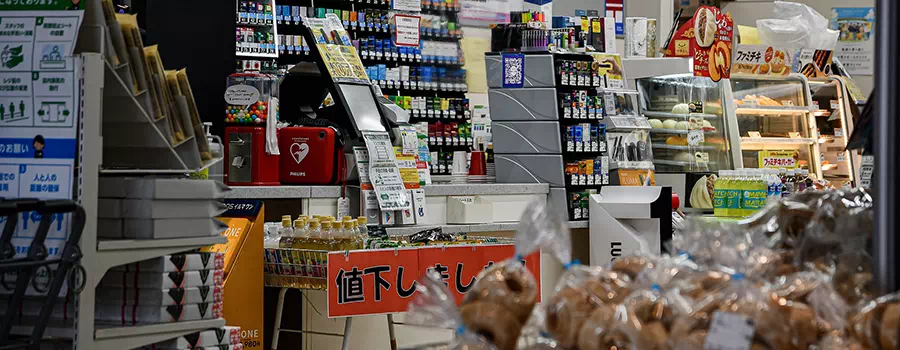
supermarket
Product Lineup
- Fresh produce
- Fruit and vegetables
fresh, quality fruit and vegetables are available. Seasonal produce is also available in abundance.
- Meat and fish
fresh meat and fish are available. Seafood in particular is often fresh for sashimi, and there is a good selection of regional specialities.
- Dairy products
milk, yoghurt, cheese, butter and many other everyday dairy products are available.
- Breads and bakery
there is a section with freshly baked breads and pastries. Some are baked in the shop, giving off a savoury aroma.
- Processed food
- Frozen food
a wide range of frozen foods, including delicatessens, pizzas, ice cream, vegetables, etc.
- Canned and bottled food
many types of canned and bottled food are available, including fish, vegetables, fruit and soups, which are useful for preserving food.
- Snacks
a wide range of snacks, including crisps, chocolate and biscuits.
- Beverages
- Soft drinks
a wide range of soft drinks including juices, carbonated drinks, tea and coffee.
- Alcoholic beverages
a wide range of alcoholic beverages are available, including beer, wine, sake, shochu and whisky.
- Household goods
- Detergents and cleaning products
laundry detergent, dishwashing detergent and cleaning products.
- Cosmetics and skin care products
a wide range of everyday cosmetics, including shampoos, conditioners, skin care creams and make-up products.
- Pet supplies
a full range of pet supplies including pet food, pet sheets and pet toys.
Features
- Quality of fresh food
Japanese supermarkets are characterised by fresh, high-quality fresh food. Seafood in particular is fresh and a large selection of sashimi-grade products is available.
- Cleanliness and orderly display
the shop is very clean and the products are displayed in an orderly manner, creating an environment conducive to shopping.
- Special days and time sales
special days are set aside on certain days of the week, when certain products are sold at reduced prices. There are also time sales during the hours before closing time, when products that need to be consumed on the same day (especially delicatessen and fresh food) can be further discounted.
Differences with other countries
- Freshness
seafood is particularly fresh and may be prepared on the spot. Sushi and sashimi can be purchased as is.
- Diverse product range
many regional specialities and seasonal products are available, reflecting local characteristics.
- Full service
in-store bakeries, delicatessens and delicatessens are available in the supermarkets, where you can buy freshly prepared meals.
Points to remember when using the supermarket
- Bring your own eco-bags
many shops charge for plastic bags in order to protect the environment. Bringing your own eco-bag saves money. In addition, it is nowadays recommended to bring your own bag.
- Point cards/membership cards
many supermarkets issue point cards or membership cards, where you can earn points for every purchase and get a discount on your next and subsequent purchases. They are easy to create, even for foreigners.
- Use of special sale days and time sales
special sale days and time sales can help you save even more money. Check leaflets and websites in advance.
- Storing fresh food
Fresh food is very fresh in Japanese supermarkets, but it is advisable to refrigerate or freeze it immediately after purchase. Seafood in particular should be cooked as soon as possible.
- Goods management and expiry dates
check the expiry dates of products when you buy them. In particular, perishable and delicatessen products should be consumed as soon as possible.
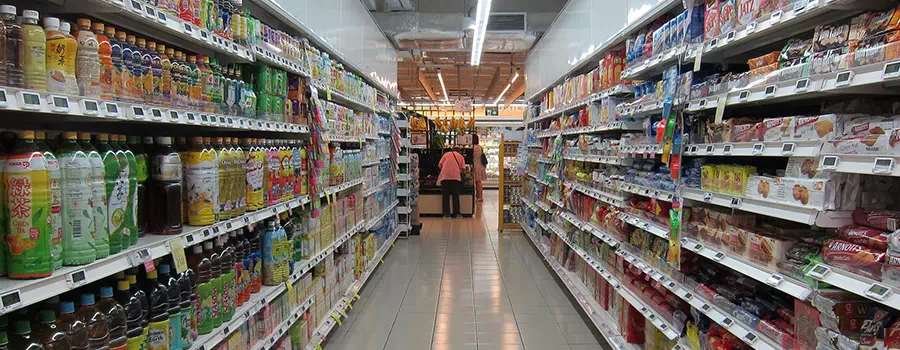
greengrocer
Product Lineup
- Vegetables
- Root vegetables
radish, carrot, burdock, potato, sweet potato, etc.
- Leafy vegetables
spinach, Chinese cabbage, cabbage, lettuce, etc.
- Fruit vegetables
tomatoes, aubergines, peppers, cucumbers, etc.
- Mushrooms
shiitake, enoki, shimeji, maitake, etc.
- Fruits
- Citrus fruits
mandarins, lemons, oranges, etc.
- Berries
strawberries, blueberries, raspberries, etc.
- Other fruits
apples, bananas, grapes, watermelons, melons, etc.
- Regional specialities
- Local specialities
a large selection of locally grown specialities. Examples include asparagus from Hokkaido, sweet potatoes from Kyushu and apples from Aomori.
- Seasonal products
- Seasonal vegetables and fruits
bamboo shoots in spring, watermelons in summer, persimmons in autumn and mandarin oranges in winter.
Features
- Freshness
fresh fruit and vegetables are available at morning markets and directly from local farmers. It is a great way to buy freshly harvested produce.
- Low prices
prices are often lower than in supermarkets, especially for seasonal vegetables and fruit, which are very affordable.
- Community-based
you can interact with local residents and get advice on how to choose vegetables and how to cook them through conversations with the shopkeeper.
- Small-batch sales
many produce is sold in small quantities, suitable for one-person households and families with a small number of people, allowing food to be used up without waste.
Differences from other countries
- Regional characteristics
many locally grown, distinctive vegetables and fruits are available, reflecting the strong regional flavour of each region of Japan.
- Quality and freshness
Japanese grocers are very particular about quality and freshness, and produce sourced directly from local farmers is particularly reliable.
- Interaction with shopkeepers
shopkeepers are friendly and knowledgeable about their produce, so you can get a lot of information when you buy.
Points to note when using the service
- Cash only
cash-only transactions are common in many grocery stores. Credit cards and electronic money are often not accepted, so it is best to have cash ready in advance.
- Bring your own eco-bags
it is recommended to bring your own eco-bags to protect the environment. As you will often have to pack the bags yourself, a sturdy eco-bag is useful.
- Opening hours
opening hours of grocery stores vary from shop to shop, but they are generally open from early morning to late evening. It is a good idea to visit early in the day as they are often not open until late at night.
- Communication
It is useful to learn some simple Japanese to enjoy communication with shopkeepers. For example, "Konnichiwa" (Hello), "Thank you" (Thank you), "What do you recommend?" (What do you recommend?).
- Product care and storage
vegetables and fruit should be stored properly to keep them fresh. It is recommended to store them in the fridge or in a cool place and consume them as soon as possible.
Convenient services
- Home delivery services
some grocers offer home delivery services, delivering fresh fruit and vegetables to your home. This is particularly convenient for the elderly and busy people.
- Recipe suggestions
shopkeepers may be able to suggest recipes for dishes using the fruit and vegetables you have purchased. This is a good opportunity to try new dishes.
- Events and tastings
local events and tastings are sometimes organised, allowing you to try new varieties of fruit and vegetables. It is also a good opportunity to meet local farmers.
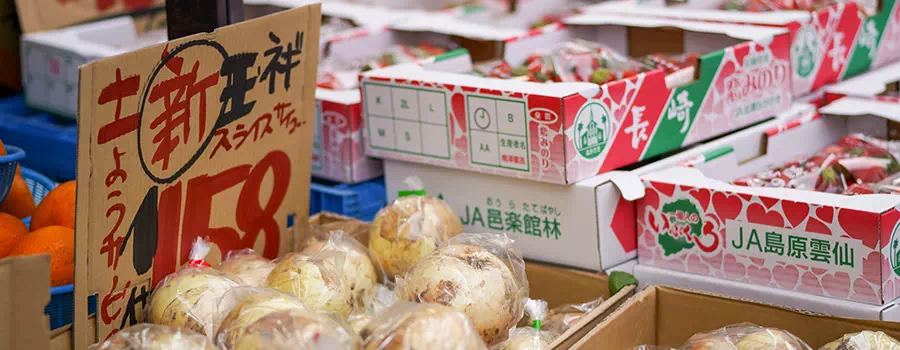
vending machine
Product Lineup
- Beverages
- Soft drinks
a wide range of carbonated drinks, juices, teas and sports drinks.
- Coffee
both hot and cold variants are available, including canned, bottled and paper-bottled coffee.
- Alcoholic drinks
some vending machines sell beer, chuhai and sake. You may need to press an age-verification button to check your age.
- Health drinks
health-conscious drinks such as vegetable juices, protein drinks and vitamin drinks are also available.
- Foodstuffs
- Snacks
chips, cookies, candies, etc.
- Ice cream
many varieties of ice cream available during the summer months.
- Hot snacks
hot canned soups, hot dogs, ramen noodles, rice cakes, etc. are available from vending machines.
- Other goods
- Sundries
umbrellas, batteries, stationery, handkerchiefs, masks and other useful emergency items.
- Regional products
limited edition products only available in the region and souvenirs for tourists are sometimes sold.
Features
- Variety of locations
vending machines can be found in a great many places, including train stations, airports, hospitals, schools, office buildings, tourist attractions, roadside stations and residential areas.
- 24-hour availability
vending machines are available 24 hours a day, so you can buy the products you need at any time. This is particularly convenient during late night and early morning hours.
- Variety of products
products change with the seasons, with cold drinks and ice cream available in summer and hot drinks and soups in winter.
- Introduction of the latest technology
some vending machines are linked to facial recognition and smartphone apps, and accept e-money and credit card payments. Some also have touch-screen operation and voice guidance.
Differences with other countries
- Installation density
Japan has the highest installation density of vending machines in the world, with vending machines located throughout the city. They can be found not only in urban areas, but also in rural and mountainous areas.
- Product diversity
In addition to beverages, a wide variety of products are sold, including food, general merchandise and regional products. Local specialities and souvenirs may be sold, especially in tourist areas.
- Variety of products
vending machines are regularly refilled and cleaned, and are always kept clean. They are highly reliable, with few breakdowns or product defects.
Points to note when using the machines
- Use of high denomination notes
many vending machines do not accept 5,000 yen or 10,000 yen notes; it is better to have 1,000 yen notes or coins ready.
- Checking hot and cold
Some vending machines may sell hot and cold drinks with the same button. Check the temperature display before purchasing.
- Payment methods
in addition to cash, an increasing number of vending machines accept electronic money (e.g. Suica, Pasmo, ICOCA), credit cards and smartphone payment apps (e.g. PayPay, LINE Pay).
- Age verification
Age verification is required at vending machines that sell alcoholic beverages and tobacco. Tobacco vending machines require a 'taspo card'.
Convenient services
- Multi-language support
some vending machines in tourist attractions and international airports are available in several languages, including English, Chinese and Korean.
- Localised products
vending machines in tourist attractions or specific regions offer limited-edition products and souvenirs that are only available in those areas.
- Health-conscious vending machines
vending machines are now also available for health-conscious consumers, offering low-calorie drinks, health foods and organic products.
- New product experiences
in recent years, vending machines selling agricultural products and fresh produce have also appeared, offering new product experiences. For example, there are vending machines where you can buy eggs, vegetables and fruit.
Examples of use
- Tourists
it is easy to buy hydration during a trip or a snack when you are hungry. It is also fun to try local products.
- Business people
even when you are busy, you can quickly buy drinks and snacks from vending machines in office buildings and at train stations.
- Night-time and early-morning use
24-hour vending machines are a convenient way to get the products you need, even late at night or early in the morning.
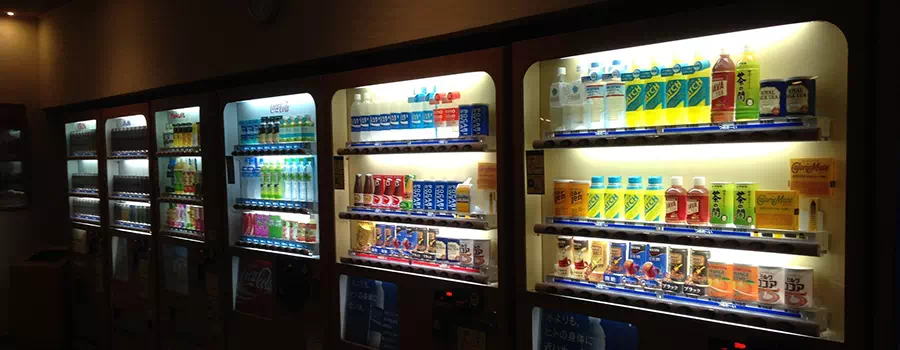
uninhabited market
Unmanned markets are automated retail facilities found throughout Japan, especially in rural and suburban areas. They are a convenient way to buy fresh produce. More information on unmanned markets is presented below.
Product Lineup
- Vegetables
mainly freshly harvested vegetables from local farmers. Examples include tomatoes, cucumbers, aubergines, cabbages, spinach, radishes and carrots.
- Fruit
seasonal fruit is available. Many local specialities can be found, such as apples, oranges, grapes, persimmons and strawberries.
- Other agricultural products
flowers, seedlings, herbs and other gardening products are sometimes sold. You may also see processed products such as rice, eggs, handmade jams and pickles.
- Local specialities
local specialities and traditional produce are available. Examples include regional specialities such as local vegetables and fruit, and popular local handmade food products.
Features
- Freshness
freshly harvested fruit and vegetables as they are supplied directly from local farmers. The quality is high and you can enjoy the best seasonal flavours.
- Low prices
because there is no middleman, prices are extremely low. You can sometimes buy at less than half the market price.
- Trust system
uninhabited markets operate on a trust-based system. Buyers generally pay a self-assessment fee, often in the form of cash in a payment box.
- Community-based
they are directly linked to local farmers and function as part of the local community. It is a place where you can get a feel for the local characteristics and climate.
Differences with other countries
- Trust-based system
uninhabited market in Japan operate based on the trust of the buyer, and a culture of honesty and payment of fees has taken root, even when the market is unmanned. This trust system is unique to Japan.
- Variety of local specialities
many local specialities and seasonal products are available, providing an interesting shopping experience for tourists.
- Variety of locations
not only in rural and suburban areas, but also in some urban areas, there are many opportunities to easily purchase fresh local produce.
Points to note when using the market
- Prepare cash (small change)
in uninhabited market, payment is generally made in small change. It is important to have small notes and coins ready in advance as change is often not given.
- Checking the quality of goods
as uninhabited market are not staffed, you need to check the quality and freshness of the goods yourself before buying. Vegetables and fruit should be checked for damage.
- Security measures
as uninhabited market are unmanned, care must be taken with cash. They operate on a trust system, but care should be taken to ensure that fraud does not occur.
- Opening hours
the opening hours of uninhabited market vary from installation to installation, but they are often open 24 hours a day. However, replenishment of goods often takes place in the morning or evening, so it is advisable to aim for those times to purchase fresh products.
Useful services
- Local information
information on local events and tourist information is sometimes posted in uninhabited market. This is a great way to get information about the local area and can be useful for tourists.
- Interaction with farmers
in some uninhabited market, local farmers may visit regularly to restock and explain their products. Through interaction with farmers, visitors can deepen their knowledge about foodstuffs.
- Contribute to local revitalisation
by using uninhabited market, you can support local farmers and contribute to revitalising the local economy. By purchasing fresh local produce, you can support sustainable local communities.
Examples of use
- Tourists
can easily purchase fresh local fruit and vegetables during their trip. Enrich the tourism experience by enjoying local specialities and seasonal produce.
- Local residents
can obtain fresh produce at low prices on a daily basis, enriching their diet. They can easily procure foodstuffs, even when they are particularly busy.
- Health-conscious consumers
some uninhabited market offer pesticide-free and organic produce, which is attractive to health-conscious consumers.
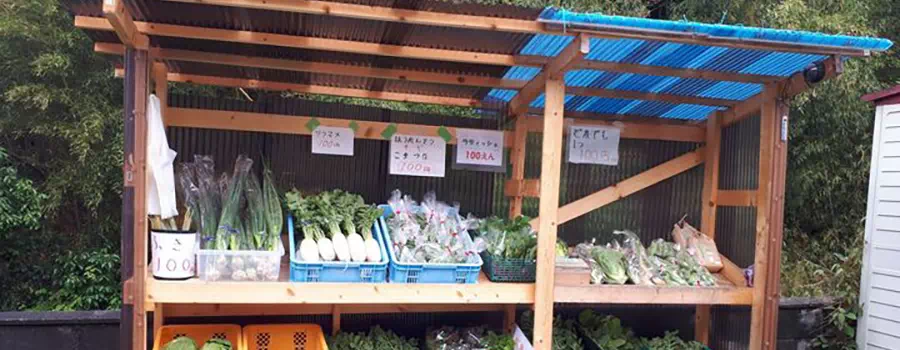 Back
Back